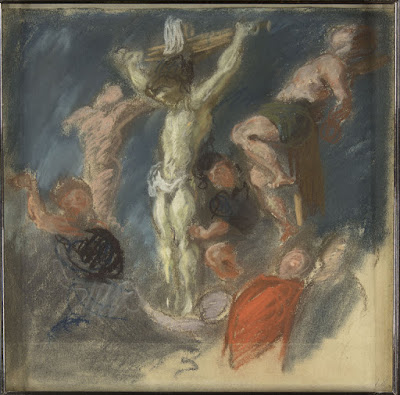 |
| Eugène Delacroix Study of a Bed ca. 1822-24 drawing, with watercolor Musée du Louvre |
 |
| Eugène Delacroix Study of a Bed ca. 1822-24 drawing, with watercolor Musée du Louvre |
 |
| Eugène Delacroix Study of a Bed ca. 1822-24 drawing, with watercolor Musée du Louvre |
 |
| Eugène Delacroix Drapery Study ca. 1825 drawing Musée du Louvre |
 |
| Eugène Delacroix Stone Staircase seen through Doorway 1834 drawing Musée du Louvre |
 |
| Eugène Delacroix Three English Landscape Views 1825 watercolor Musée du Louvre |
 |
| Eugène Delacroix Turk on Horseback ca. 1824-25 watercolor Musée du Louvre |
 |
| Eugène Delacroix Sheet of Studies (17th-century costume) ca. 1830 drawing, with watercolor Musée du Louvre |
 |
| Eugène Delacroix Old Shepherd addressing Young Shepherd ca. 1858-62 drawing Musée du Louvre |
 |
| Eugène Delacroix Sheet of Studies before 1863 drawing Musée du Louvre |
 |
| Eugène Delacroix Denial of St Peter 1862 drawing Musée du Louvre |
 |
| Eugène Delacroix Mars in his Chariot ca. 1833 drawing Musée du Louvre |
 |
| Eugène Delacroix Nereid and Hippogriff ca. 1850 drawing Musée du Louvre |
 |
| Eugène Delacroix after Peter Paul Rubens Figures from The Way to Calvary ca. 1850 drawing Musée du Louvre |
 |
| Eugène Delacroix after Peter Paul Rubens Memory of the Coup de Lance in Antwerp 1850 drawing (colored chalks) Musée du Louvre |
"The process of conception of this great artist is no less slow, serious and conscientious than his execution is nimble. This moreover is a quality which he shares with the painter whom public opinion has set at the opposite pole from him – I mean M. Ingres. But travail is by no means the same thing as childbirth, and these great princes of painting, though endowed with a seeming indolence, exhibit a marvellous agility in covering a canvas. . . . Nature for Eugène Delacroix, is a vast dictionary whose leaves he turns and consults with a sure and searching eye; and his painting, which issues above all from the memory, speaks above all to the memory. The effect produced upon the spectator's soul is analogous to the artist's means."
– from The Salon of 1846, published in Art in Paris, 1845-1862: Salons and Exhibitions reviewed by Charles Baudelaire, translated and edited by Jonathan Mayne (London: Phaidon Press, 1965)